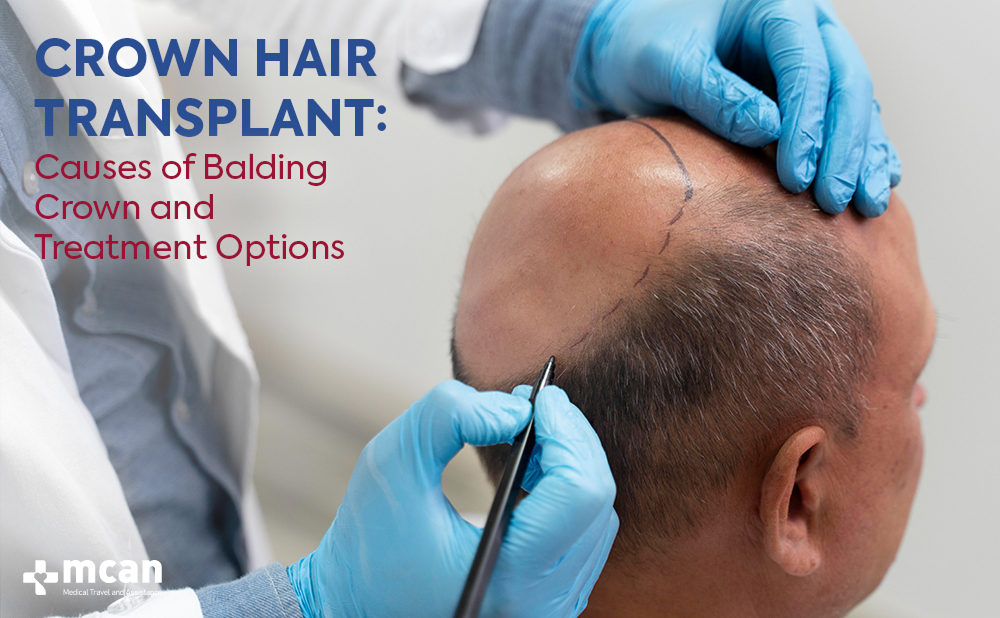
Hair loss at the crown, also known as crown balding or vertex thinning, is a gradual but highly common pattern of hair loss. It often begins as a small spot on the top-rear of the scalp and slowly expands over time. Because it develops out of direct view, many people don’t notice crown balding until it’s well advanced, often visible only in photos or under bright lighting.
While it may seem less urgent than a receding hairline, crown hair loss can have a major impact on the overall appearance of density and hair coverage. If left untreated, the thinning can progress to a fully bald patch that is difficult to conceal.
In this article, we’ll explore the most important aspects of crown balding: what causes it, how to recognize it, and why it often requires a different treatment approach than other types of hair loss. We’ll also take a close look at crown hair transplant, including how it works, how many grafts are needed, which techniques are used, and what kind of results patients can expect.
Where is the Crown of the Head?
The crown, also called the vertex, is the upper back part of the scalp. It sits slightly behind the highest point of the skull and is where the hair naturally forms a spiral or whorl pattern. This area plays an important role in the overall perception of hair volume and scalp symmetry.
In a healthy scalp, the crown blends seamlessly with the surrounding hair, contributing to a full and balanced appearance. However, when hair loss begins in the crown, the circular pattern makes thinning more noticeable, especially under direct light or when viewed from above.
Unlike the hairline, which is visible head-on, the crown is often out of sight during daily life. As a result, crown balding may progress significantly before a person becomes fully aware of it. Identifying the crown area early is important for timely intervention and effective treatment.

What is Crown Balding?
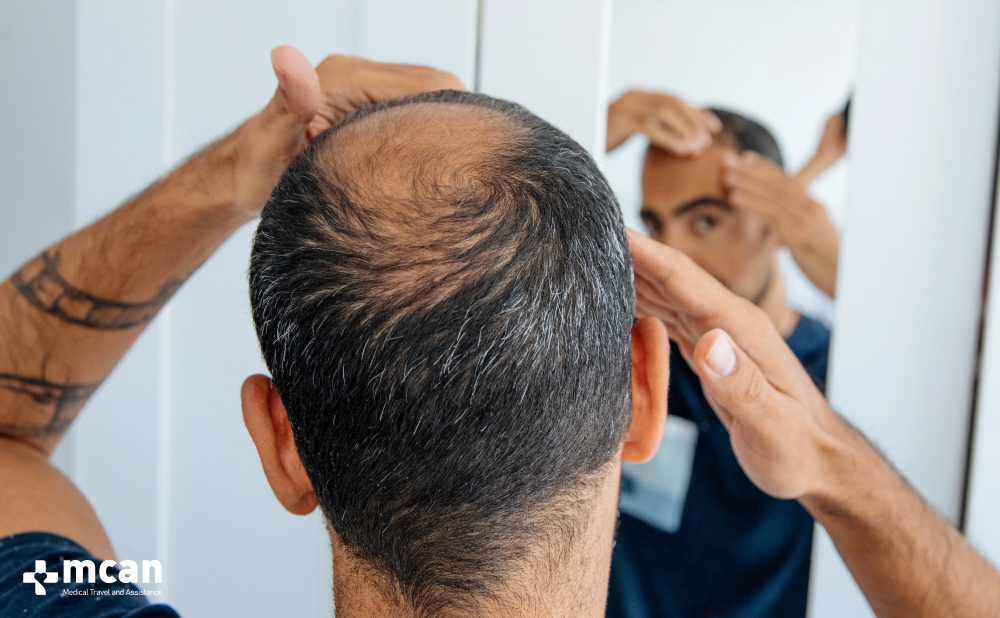
Crown balding refers to hair loss that starts at the crown, or vertex, of the scalp. It typically begins as a small thinning area that slowly enlarges over time, often forming a circular bald spot. In many cases, the thinning may remain unnoticed until it becomes more advanced, especially since the crown is not easily visible in daily life.
This type of hair loss is a hallmark of androgenetic alopecia, also known as male pattern baldness, although it can also affect women. The pattern of crown balding varies from person to person. Some experience isolated thinning in the crown, while others see it progress and eventually connect with receding hairline areas, creating a larger bald region.
The progression of crown hair loss is commonly categorized using the Norwood Scale, a widely used system that defines the stages of male pattern baldness. Crown balding is often seen in Stage III Vertex and becomes more prominent in Stages IV to VII, depending on severity. For a broader look at how different types of hair loss appear and progress, you can explore our guide on Understanding the Different Types of Alopecia.
Recognizing crown balding early can make a significant difference in planning treatment and achieving better outcomes.
Causes of Crown Balding
The most common cause of crown balding is androgenetic alopecia, also known as hereditary or male pattern hair loss. This condition affects millions of men worldwide and is driven by a combination of genetics and hormonal changes.
Key causes of crown hair loss include:
- Genetics: A family history of hair loss significantly increases the likelihood of developing crown balding. If close relatives experienced similar hair loss patterns, the chances are higher that it will affect you too.
- DHT sensitivity: Dihydrotestosterone (DHT) is a byproduct of testosterone that causes hair follicles in the crown to shrink over time. These weakened follicles produce thinner strands and eventually stop growing hair altogether.
- Age: Hair loss in the crown often becomes more noticeable with age. Many men begin to see signs in their late 20s or 30s, with the process accelerating over time.
- Scalp health: Conditions such as seborrheic dermatitis, psoriasis, or chronic inflammation can impact hair growth in the crown area if left untreated.
- Stress and lifestyle factors: High stress levels, poor nutrition, and lack of sleep can contribute to overall hair thinning, including in the crown. While not direct causes, they can accelerate the progression of hair loss.
Signs of Crown Hair Loss
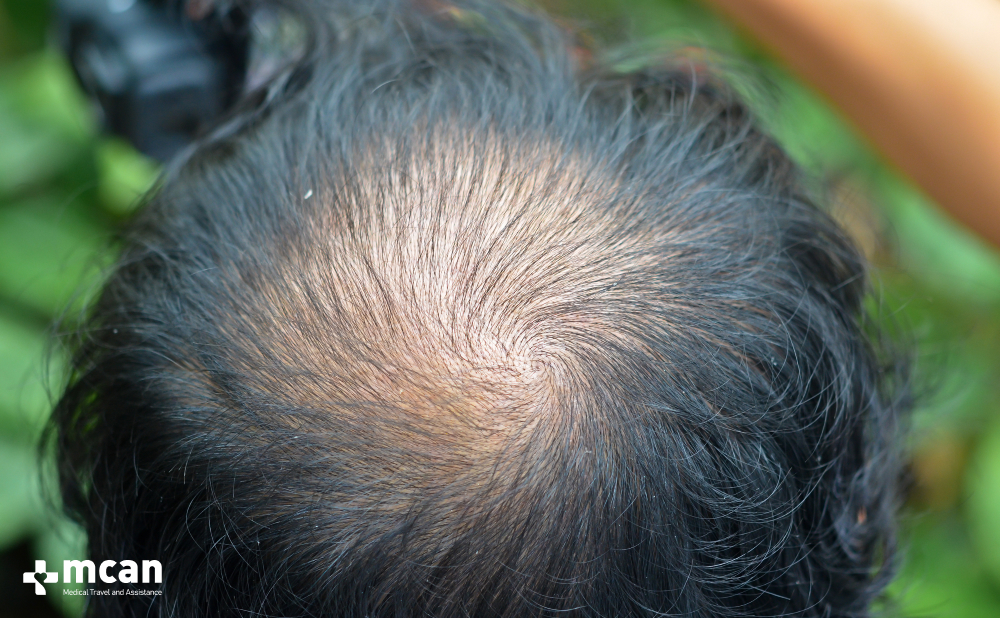
Crown hair loss usually starts gradually, making it harder to detect in its early stages. Because the crown sits at the top-rear of the scalp, it’s not easily visible during everyday routines.
Common indicators of crown balding are:
- Thinning at the vertex, especially noticeable under bright light
- A circular or widening bald spot that becomes more defined over time
- Increased scalp visibility in photographs, particularly from higher angles
- Changes in how your hair sits or parts, with less coverage at the back
- A softer, less dense texture when you run your fingers through the area
These signs often appear subtly and may go unnoticed for months. Paying attention to changes in hair texture, light reflection, or coverage patterns can help identify crown balding early enough to explore appropriate treatments.
Non-Surgical Treatment Options for Crown Balding
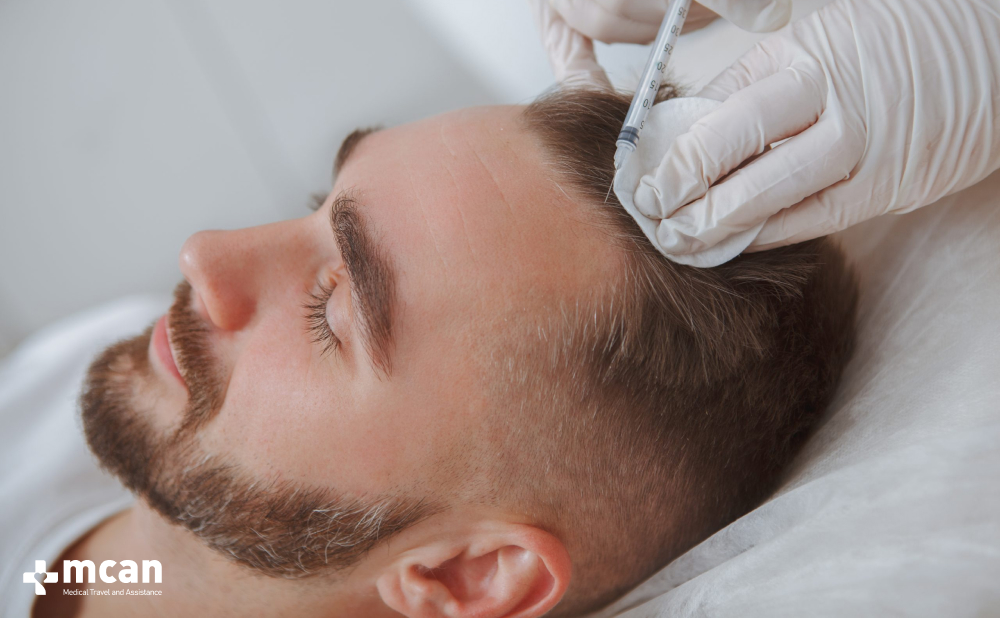
Non-surgical methods such as scalp therapies or topical treatments may offer mild improvement in hair density, especially in the early stages of crown thinning. Options like PRP therapy or microneedling can help support scalp health and stimulate weakened follicles.
However, these approaches are generally limited in reversing noticeable crown balding. Once the area has become visibly thin or bald, they are unlikely to restore significant hair coverage.
In such cases, crown hair transplant remains the most effective and permanent solution, especially for individuals seeking natural density and long-term results.
Crown Hair Transplant as a Permanent Solution
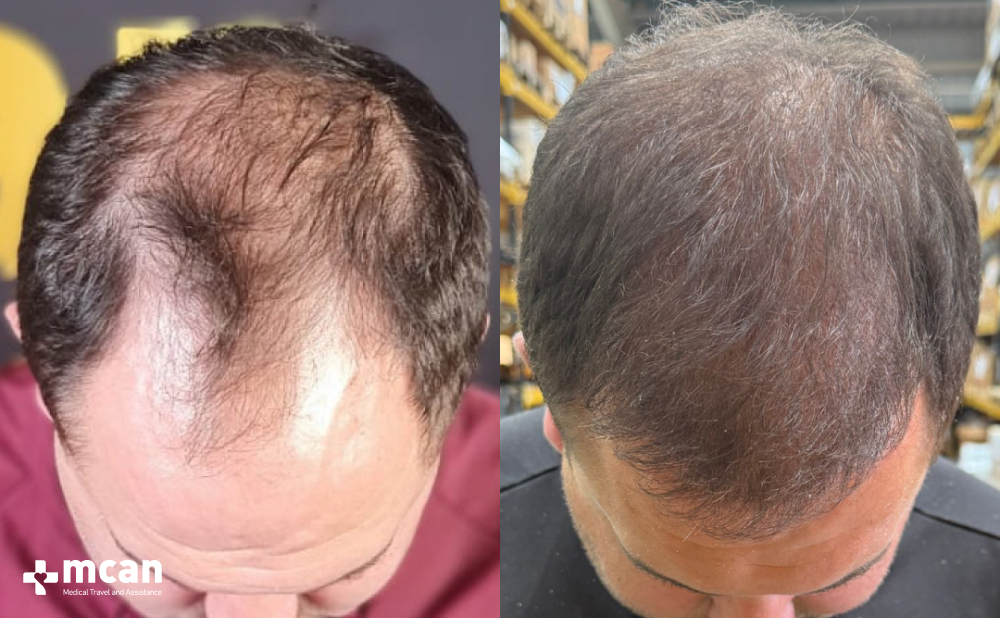
A crown hair transplant is a surgical procedure that restores hair in the vertex area by relocating healthy follicles from the back or sides of the scalp. These follicles are genetically resistant to hair loss and, once transplanted, continue to grow naturally for life.
What makes the crown area unique is its spiral growth pattern. Unlike the frontal hairline, the crown has a circular structure that requires precise planning and placement of grafts. Achieving a natural result here depends not only on the number of grafts but also on how well the original direction and density are recreated.
Hair transplant is often the most effective option once the crown has begun to show visible thinning or baldness. Non-surgical treatments may help slow the process, but they typically fall short when it comes to reversing established hair loss in the crown.
For individuals with stable hair loss and a suitable donor area, a crown transplant offers a permanent, reliable, and natural-looking solution. When performed with skill and attention to the crown’s specific anatomy, the results blend naturally with the surrounding hair and restore confidence from every angle.
Graft Requirements for Crown Area
The number of grafts needed for a crown hair transplant depends on several factors, including the size of the balding area, the desired density, and the quality of the donor hair. Because the crown covers a relatively wide surface and requires circular placement for a natural look, it often needs more grafts than other areas of the scalp.
In general, crown transplants are planned more conservatively than hairline procedures. This is to ensure a balance between coverage and preserving enough donor hair for possible future needs.
Here’s a general breakdown of estimated graft requirements based on the level of crown balding:
| Crown Balding Severity | Estimated Grafts Needed |
|---|---|
| Mild thinning | 1,000 – 1,500 |
| Moderate loss | 1,500 – 2,500 |
| Advanced balding | 2,500 – 3,500+ |
These numbers serve as a guide. The exact graft count can only be determined during a personal assessment, which takes into account your hair characteristics, scalp condition, and future hair loss progression.
If you’re unsure how many grafts you might need overall, our detailed article on Hair Transplant Graft Counts: How to Know the Right Number for You can help you understand how grafts are planned based on hair loss severity.
Techniques Used in Crown Hair Transplant
Different hair transplant techniques can be used to restore the crown area, each with its own strengths depending on the size of the balding region, hair type, and natural crown pattern. The choice of technique affects how well the transplanted hair blends with the existing hair and how precisely the natural swirl of the crown is recreated.
Here’s a quick comparison of the most commonly used methods for crown hair transplantation:
| Technique | Application in Crown Area | Advantages |
|---|---|---|
| FUE | Suitable for small to moderate crown areas with flexible graft placement | No linear scar, good for circular design, effective for most crown cases |
| Sapphire FUE | Ideal for denser crown coverage requiring refined angling and tighter spacing | Higher precision, faster healing, better graft survival in the swirl pattern |
| DHI | Used for small, localized crown transplants where direction and density control are critical | Direct implantation, no need to open channels in advance, reduces graft trauma |
Crown Hair Transplant Success Rate
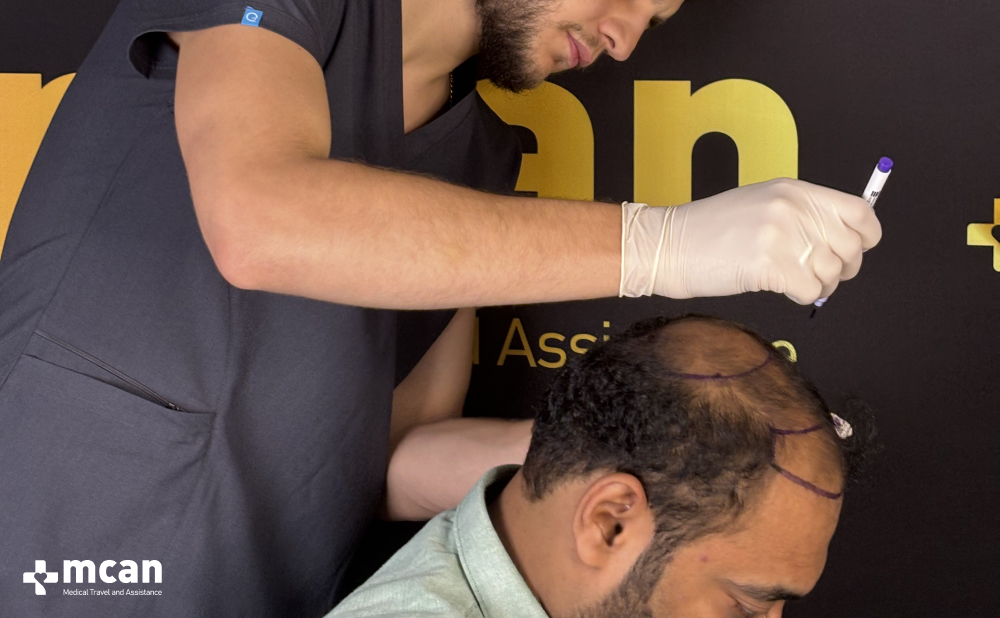
A successful crown hair transplant depends on factors such as proper planning, graft survival, and the precision of graft placement to recreate the natural spiral pattern of the crown. While technically more demanding, modern techniques make high success rates achievable when performed by experienced specialists.
Key factors that influence success:
- Expertise in crown-specific transplantation
- Graft survival rates typically range between 90% and 95%
- Donor hair quality and individual hair characteristics
- Stable hair loss pattern to minimize future progression
- Consistent post-operative care, especially in the first two weeks
Expected growth timeline after crown hair transplant:
- 3–4 months: Initial new growth begins
- 6–9 months: Noticeable improvement in coverage
- 12 months: Final density and texture are generally visible
Compared to other areas of the scalp, the crown may take slightly longer to show results, but with proper planning, it offers a reliable and lasting solution to localized hair loss. For a full breakdown of recovery phases and when to expect results, visit our detailed post on Hair Transplant Timeline: A Guide to Hair Transplant Recovery & Growth Chart.
Crown Hair Transplant in Turkey with Trusted Expertise
The success of a crown hair transplant depends on more than just the procedure itself. It involves careful planning, choosing the right technique for the crown’s natural spiral pattern, and working with a team that understands how to restore density in this complex area. From donor area management to precise graft placement, each step plays a critical role in the final result.
At MCAN Health, every crown transplant is performed with long-term success in mind. With internationally accredited standards, a skilled medical team, and personalised treatment planning, we focus on achieving outcomes that are both natural-looking and lasting.
If you are considering a crown hair transplant in Turkey, MCAN Health provides the experience, medical infrastructure, and aftercare support needed to restore your crown with confidence and results that endure.
Frequently Asked Questions
Is a crown hair transplant suitable for all stages of crown balding?
Crown hair transplant is most effective when hair loss has stabilised. In very early stages, it may be too soon to assess the final pattern. In very advanced cases, planning must ensure donor hair is used efficiently. A personalised consultation is essential to determine timing and suitability.
Why is the angle of implantation important in crown hair transplant?
The crown has a natural spiral or swirl pattern. To achieve a natural look, each graft must be implanted following this direction. Poor angling can lead to unnatural growth patterns or uneven density in the crown area.
Can crown hair transplant be done in multiple sessions?
Yes. In cases of extensive crown balding or when preserving donor supply for future needs, the transplant may be planned over two stages. This approach helps ensure density while managing long-term hair restoration goals.
What should I avoid after a crown hair transplant?
Avoid leaning back on hard surfaces, resting your head against chairs, and wearing tight hats for the first few weeks. These actions can put pressure on the crown area, which may disturb newly implanted grafts during early healing.
Does crown hair transplant affect the donor area more than other procedures?
Because crown restorations often require a higher number of grafts, donor management becomes especially important. A skilled surgical team will ensure grafts are harvested evenly to maintain a natural look and avoid overharvesting.
Are results from crown hair transplant permanent?
Yes. The transplanted follicles are resistant to the hormones that cause crown balding. Once implanted and fully grown, the new hair behaves like natural hair and continues to grow permanently.
 Best Age for Hair Transplant: When Should You Consider the Procedure?
Best Age for Hair Transplant: When Should You Consider the Procedure?  5 Signs You Are Ready for a Hair Transplant: What to Look For
5 Signs You Are Ready for a Hair Transplant: What to Look For